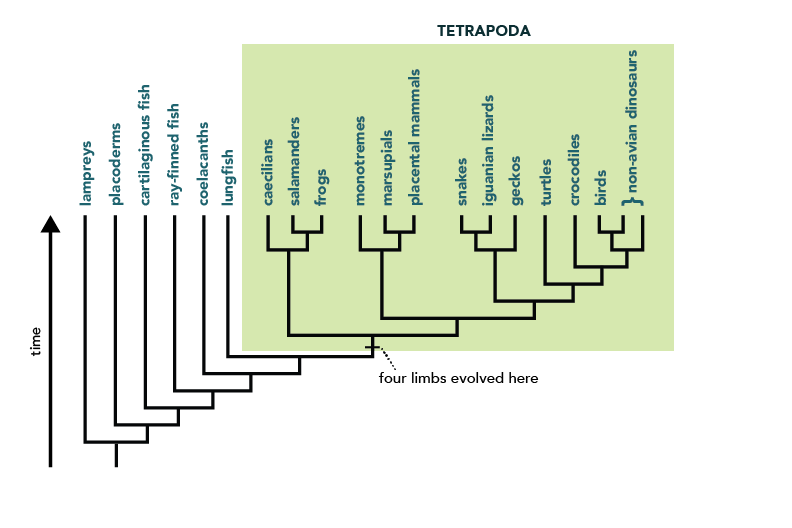Like family trees, phylogenetic trees represent patterns of ancestry. However, while families have the opportunity to record their own history as it happens, evolutionary lineages do not — species in nature do not come with pieces of paper showing their family histories. Instead, biologists must reconstruct those histories by collecting and analyzing evidence, which they use to form a hypothesis about how the organisms are related — a phylogeny.
To build a phylogenetic tree such as the one shown below, biologists collect data about the characters of each organism they are interested in. Characters are heritable traits that can be compared across organisms, such as physical characteristics (morphology), genetic sequences, and behavioral traits.
In order to construct the vertebrate phylogeny, we begin by examining representatives of each lineage to learn about their basic morphology, whether or not the lineage has vertebrae, a bony skeleton, four limbs, an amniotic egg, etc.
Using shared derived characters
Our goal is to find evidence that will help us group organisms into less and less inclusive clades. Specifically, we are interested in shared derived characters. A shared character is one that two lineages have in common, and a derived character is one that evolved in the lineage leading up to a clade and that sets members of that clade apart from other individuals.
Shared derived characters can be used to group organisms into clades. For example, amphibians, turtles, lizards, snakes, crocodiles, birds and mammals all have, or historically had, four limbs. If you look at a modern snake you might not see obvious limbs, but fossils show that ancient snakes did have limbs, and some modern snakes actually do retain rudimentary limbs. Four limbs is a shared derived character inherited from a common ancestor that helps set apart this particular clade of vertebrates.

However, the presence of four limbs is not useful for determining relationships within the clade in green above, since all lineages in the clade have that character. To determine the relationships in that clade, we would need to examine other characters that vary across the lineages in the clade.
Learn more about how phylogenies can be constructed using parsimony, or get all the details about building trees.
Teach your students about evolutionary relationships and phylogenetics:
- What did T. rex taste like?, a web activity for grades 6-12
Find additional lessons, activities, videos, and articles that focus on phylogenetics.
